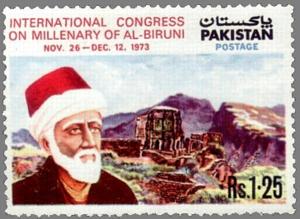
Persian scholar, b. September 973 (Khwarezm, Khorasan), d. 13 December 1048 (Ghazna, Afghanistan).

Al-Biruni was born into a Persian family of Shi'ite Muslim faith. From his writings it appears that he was not a practicing Muslim and possibly an agnostic. Although he wrote in Arabic he was a Persian nationalist and strongly opposed to Arab influence in his country.
Al-Biruni was an outstanding scholar and probably the most learned person of the Middle Ages. He spoke Turkish, Persian, Sanskrit, Hebrew, Syriac and Arabic. Some time after 1017 he travelled to India to study the Indian civilization and then lived in Ghazna in Afghanistan for the rest of his life.
Al-Biruni's works cover nearly all areas of science, from astronomy, chronology and mathematics to physics, medicine and history. In astronomy and mathematics he introduced the Indian concept of an Earth that rotates on its axis into Arabic science and reiterated the usefulness of the Indian number system. In physics he excelled particularly in the application of hydrostatics; he explained natural springs through the principle of communicating vessels and determined accurately the specific weight of 18 precious stones and metals.
Al-Biruni's geographical work benefited from his mathematical training. He developed a stereographic projection and explained how to make accurate geodetic measurements and determine latitudes and longitudes. Al-Biruni stated that the Indus valley had once been a sea and had evolved through alluvial deposition, an idea that was revolutionary for his time.
Among al-Biruni's major works are
Al-Biruni also worked as a translator of Sanskrit texts, including two treatises written by Varahamihira some 400 years earlier.